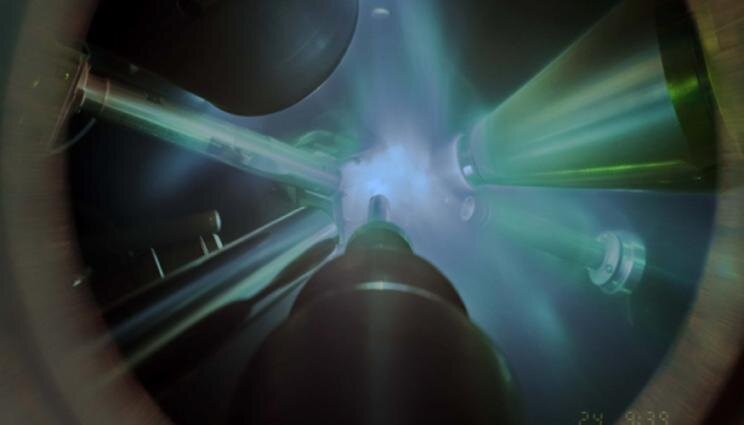Lawrence Livermore National Laboratory (LLNL) researchers have explored high-pressure behavior of shock-compressed tantalum at the Omega Laser Facility at the University of Rochester’s Laboratory for Laser Energetics (LLE). The work showed tantalum did not follow the predicted phase changes at high pressure and instead maintained the body-centered cubic (BCC) phase until melt.
The results of the work are featured in a Physical Review Letters paper and focuses on how researchers studied the melting behavior of tantalum at multi-megabar pressures on the nanosecond timescale.
“This work provides an improved physical intuition for how materials melt and respond at such extreme conditions,” said Rick Kraus, lead author of the paper. “These techniques and improved knowledge base are now being applied to understanding how the iron cores of rocky planets solidify and also to more programmatically relevant materials as well.”
Kraus said the research settled a long-standing controversy about the high pressure and high temperature phase diagram of tantalum, showing that BCC is the stable phase at high pressures and the melt curve is steeper than many previous measurements.
Beyond the scientific importance of the phase diagram of tantalum itself, this work is part of a broader effort to develop dynamic compression platforms to accurately constrain the melting and solidification transitions. These efforts help to ensure researchers are simulating these transitions correctly when predicting the results of a dynamic event such as forming an impact crater or accelerating an ablator at the National Ignition Facility.
This work represents a new frontier for the in-situ characterization of materials under extreme conditions. In previous experiments, melting under shock compression had been inferred indirectly by discontinuous changes in the shock velocity or in the optical properties. “Being able to ‘watch’ the structure transform from a solid to a liquid is extremely exciting,” adds Federica Coppari, co-author of the study.
With the researchers’ clear determination of melt at such extreme conditions and on short-timescale experiments, the team helped to constrain the time-dependent behavior of melting and find that dynamic experiments such as these are observing the equilibrium phase boundary.
The experiments used a single beam of the Omega laser to generate a strong shockwave in the tantalum sample. The team created a plasma-based X-ray source for the X-ray scattering measurements by using another 12 beams. In each successive experiment, the team increased the strength of the shockwave in the sample, evaluating the state of the tantalum using the X-ray diffraction diagnostic, called Powder X-Ray Diffraction Image Plate (PXRDIP).
“We observed a transition from solid BCC, to a mixed phase of BCC and liquid tantalum, to completely liquid tantalum,” Kraus said. “Using the transition pressures we obtained from these experiments, and previous equation-of-state information about tantalum, we were also able to constrain the melting temperature of tantalum.”
Tantalum has seen tremendous study under high pressure with discrepant melting curve measurements. “Therefore, it is important for us to be able to resolve controversies in highly studied materials so that we can ensure we are using the right techniques that are accepted by the research community,” he said.
Physicists produce world’s first neutron-rich, radioactive tantalum ions
More information:
R. G. Kraus et al, Melting of Tantalum at Multimegabar Pressures on the Nanosecond Timescale, Physical Review Letters (2021). DOI: 10.1103/PhysRevLett.126.255701
Provided by
Lawrence Livermore National Laboratory
Citation:
Exploring how tantalum behaves at high pressures and temperatures (2021, August 18)
retrieved 18 August 2021
from https://phys.org/news/2021-08-exploring-tantalum-high-pressures-temperatures.html
This document is subject to copyright. Apart from any fair dealing for the purpose of private study or research, no
part may be reproduced without the written permission. The content is provided for information purposes only.

